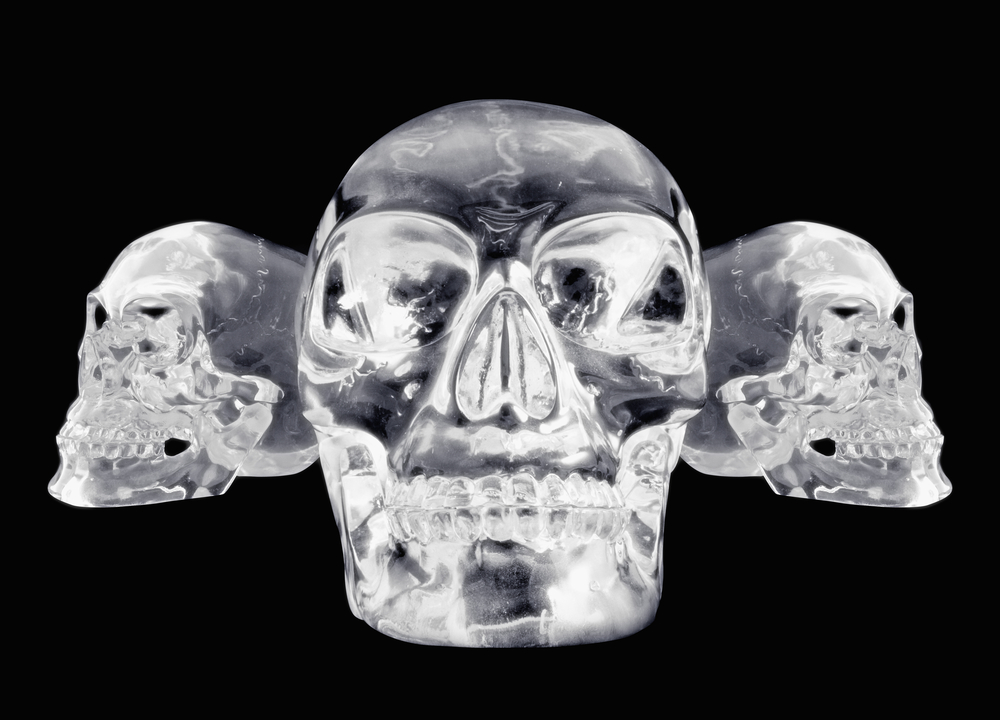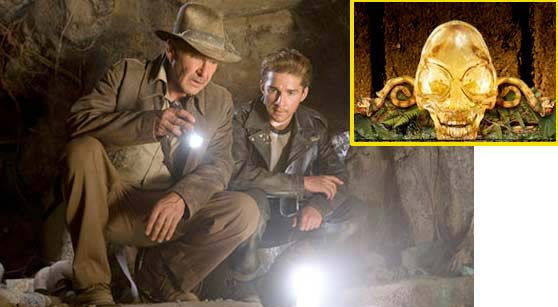Crystal Skulls: Legend, Vodka & Indiana Jones

Crystal skulls are among the strangest and most mysterious artifacts in the world. They have been displayed in the finest museums; they have inspired books, films, legends and liquor. According to some they even have supernatural power.
Skulls are, of course, made of minerals; bone is mostly calcium phosphate and calcium carbonate. Skulls are at once both mundane and macabre, symbolic reminders of both healing medicine and death. Of all the materials that a skull might be made of, crystal is perhaps the most intriguing. Crystals are central to New Age beliefs, and New Agers have constructed an intricate belief system around them involving auras, reincarnation, chakras, healing, vibrations, and so on.
There are many skulls in the world carved out of quartz, of varying sizes and designs (New Age shops around the world are well-stocked), though not all of them are steeped in myth and romance. There are only a handful of the largest, life-size skulls in existence, and they have inspired awe for generations. They are said to be hundreds or thousands of years old, and possibly of Mayan, Aztec, or even Atlantean origin. The skulls are indeed a sight to behold. Beyond the artistry of carved crystal, many believe the skulls have special abilities, such as aiding psychic abilities, healing the sick, and even having power over death.
Crystal skulls have captured the imagination of countless New Agers, curiosity seekers, and others; screenwriter George Lucas was so intrigued by crystal skulls he wrote a script about them: the 2008 film "Indiana Jones and the Kingdom of the Crystal Skulls." A Canadian company called Crystal Head Vodka (co-founded by actor and paranormal buff Dan Aykroyd) launched in 2008, bottling its crystal-filtered libation in novelty glass skulls.
The Skull of Doom
The most famous crystal skull is the so-called Skull of Doom, a human-like skull composed of two pieces and made from clear crystal quartz. It is just over five inches high, nearly five inches wide and nearly eight inches long. It weighs 11 pounds 7 ounces. The book "Arthur C. Clarke's Mysterious World" called it "the weirdest gem in the world ... one of a handful of strange man-made objects that have challenged the ingenuity of the world's scientists." The skull was rumored to have the power to kill: When a priest concentrated on the powerful relic, the skull could kill anyone at the priest's command.
It was supposedly found in the 1920s at a lost Mayan ruin in the Central American country of Belize by an explorer named F.A. Mitchell-Hedges. His adopted daughter, Anna Mitchell-Hedges, discovered the skull while exploring the ruins on her 17th birthday. Though locals clearly revered the skull as an ancient and powerful artifact, the pair returned to England with it and Anna regularly exhibited the skull after her father's death in 1959. Strange powers and characteristics were attributed to the skull; some said they could see the future when staring at it for long hours by candlelight; others that the skull defied the laws of physics by always maintaining a constant temperature of 70 degrees Fahrenheit, regardless of whether it was refrigerated or heated. This and other skulls were also said to not have any evidence of being carved by human hands or modern machines.
The skull was revered for decades, until research revealed that neither Anna nor her father found the skull in Belize or anywhere else. Instead, Mr. Mitchell-Hedges bought the skull from an antiquities collector in 1933. Anna made up the Indiana Jones-worthy adventure story about finding it in the jungle ruins of a lost city. The supposed strange abilities of the skull — including foretelling the future and keeping a constant temperature — were merely myths that had arisen over the decades.
The Skull of Doom hoax not only fooled New Agers for years, but also, apparently, an archaeologist in Belize who last year sued filmmakers behind "Indiana Jones and the Kingdom of the Crystal Skull," claiming that the story is based upon a national treasure looted nearly a century ago. It was argued that if the crystal skull had been illegally removed from Belize and used as part of a famous movie, the country should be entitled to a cut of the profits and the return of the stolen skull. Of course, since that never actually happened, the lawsuit went nowhere and was widely seen as a publicity stunt.

Science and the skulls
Supernatural or not, the crystal skulls are rare and impressive pieces of art. But where did they come from? Who made them, and how? Doubts about the skulls' supposed ancient origins circulated for decades. In 2005, an anthropologist at the Smithsonian examined several skulls with high-power microscopes and found that the cuts into the crystal unmistakably showed evidence of modern, not ancient, carving techniques. Not only were the cuts and grooves done with modern lapidary wheels, but the skulls themselves were polished with modern machinery.
It turned out that the skulls are not ancient, nor from the Maya or Aztec societies (nor, for that matter, Atlantis). Most of them were made by skilled European craftsmen in the late 1800s and early 1900s. Though the crystal skulls apparently have no supernatural abilities — healing, death, prophecy, or otherwise — they do have one undeniable, proven quality: the power to fascinate.
Benjamin Radford is deputy editor of "Skeptical Inquirer" science magazine and author of six books, including "Scientific Paranormal Investigation: How to Solve Unexplained Mysteries." His website is www.BenjaminRadford.com.
Sign up for the Live Science daily newsletter now
Get the world’s most fascinating discoveries delivered straight to your inbox.











